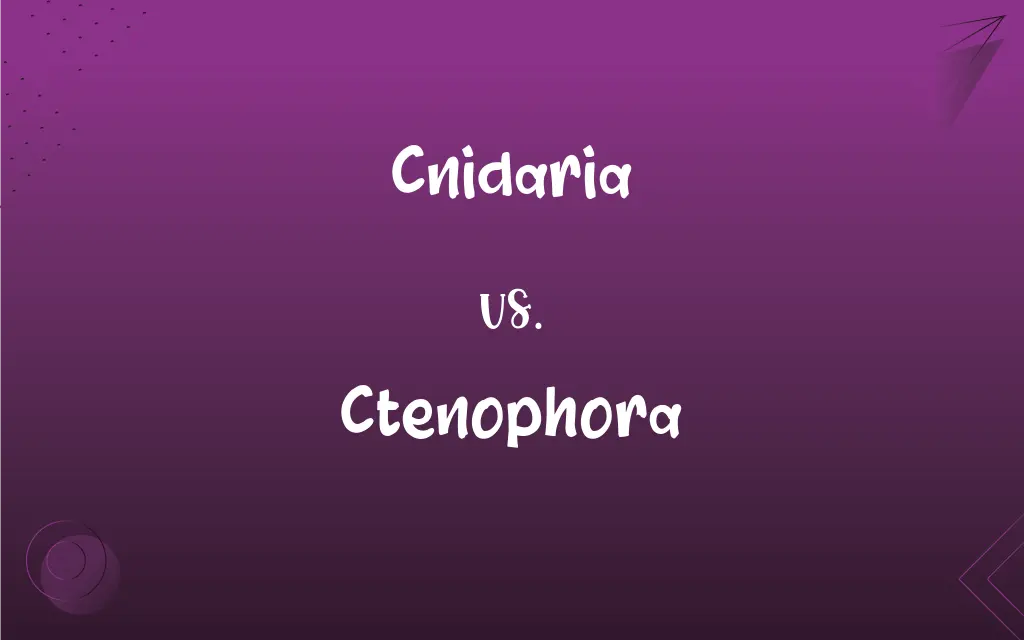Cnidaria vs. Ctenophora: What's the Difference?
Edited by Aimie Carlson || By Harlon Moss || Updated on October 16, 2023
Cnidaria includes animals like jellyfish and corals with stinging cells, while Ctenophora comprises comb jellies with cilia and no stinging cells.

Key Differences
Cnidaria is a diverse phylum encompassing over 10,000 species, including jellyfish, corals, and sea anemones. Ctenophora, on the other hand, contains fewer species, primarily known as comb jellies.
While both cnidaria and ctenophora are gelatinous and can resemble each other, they have distinct differences. Cnidaria possesses specialized cells called cnidocytes that release venom, while ctenophora lacks these stinging cells.
Ctenophora is characterized by rows of ciliary combs, which they use for movement. Cnidaria typically move through muscular contraction or drifting, although some species have limited swimming abilities.
Reproduction in cnidaria can be both asexual and sexual, and many have complex life cycles with polyp and medusa stages. Ctenophora primarily reproduces sexually, and their lifecycle is more direct than cnidarians.
The evolutionary relationship between cnidaria and ctenophora is debated. Although they share similarities, they also have fundamental differences in their nervous system and body organization.
ADVERTISEMENT
Comparison Chart
Stinging Cells
Yes (cnidocytes)
No
Movement Mechanism
Muscular contraction
Ciliary combs
Primary Representatives
Jellyfish, Corals, Sea anemones
Comb jellies
Evolutionary Relation
Ancient lineage
Debated relationship
Cnidaria and Ctenophora Definitions
Cnidaria
A phylum of aquatic animals containing stinging cells.
Jellyfish are the most recognized members of the cnidaria phylum.
ADVERTISEMENT
Ctenophora
A phylum of gelatinous animals known as comb jellies.
The beautiful bioluminescence of ctenophora makes them a marvel in deep-sea explorations.
Cnidaria
Animals with a life cycle that often includes both polyp and medusa stages.
The life stages of many cnidaria are complex, transitioning from polyps to medusas.
Ctenophora
Characterized by rows of ciliary combs used for movement.
The rows of cilia on ctenophora shimmer and reflect light as they move.
Cnidaria
Characterized by radial symmetry and a single body cavity.
Corals, belonging to cnidaria, have radial symmetry making them look similar from all angles.
Ctenophora
Primarily carnivorous, feeding on small organisms.
Ctenophora use their tentacles to capture and feed on tiny marine creatures.
Cnidaria
Known for their cnidocytes or stinging cells.
The painful sting of a jellyfish is due to the cnidocytes present in cnidaria.
Ctenophora
Possess a simple and direct life cycle.
The lifecycle of ctenophora is straightforward, with little variation between species.
Cnidaria
Primarily marine organisms with some freshwater species.
While most cnidaria are marine, a few species can be found in freshwater habitats.
Ctenophora
Lacks specialized stinging cells.
Unlike jellyfish, touching ctenophora typically doesn't result in a sting.
Cnidaria
Cnidarian
Ctenophora
A phylum of invertebrates, commonly ellipsoidal in shape, swimming by means of eight longitudinal rows of paddles. They are commonly called the comb jellies, because the separate paddles somewhat resemble combs. This phylum was formerly classified as a subdivision (class) within the Cœlenterata.
Cnidaria
A comprehensive group equivalent to the true Cœlenterata, i. e., exclusive of the sponges. They are so named from presence of stinging cells (cnidae) in the tissues. See Coelenterata.
Ctenophora
Comb jellies; sea acorns; a small phylum formerly considered a class of Coelenterata
Cnidaria
Hydras; polyps; jellyfishes; sea anemones; corals
FAQs
Are comb jellies bioluminescent?
Many ctenophora species exhibit bioluminescence, producing light in dark waters.
Do all cnidaria sting?
Most cnidaria have stinging cells, but not all stings are harmful to humans.
Do cnidaria have brains?
No, cnidaria have a nerve net but lack a centralized brain.
Are cnidaria and ctenophora closely related?
While they share similarities, their evolutionary relationship is a topic of debate.
Are there any known symbiotic relationships involving ctenophora?
While cnidaria have well-known symbioses (like with zooxanthellae), ctenophora's symbiotic relationships are less documented.
How do cnidaria protect themselves?
Their stinging cells, or cnidocytes, deter many predators.
How do ctenophora move?
They use rows of ciliary combs for movement.
Is it safe to touch a comb jelly?
Generally, yes. Ctenophora do not possess stinging cells like many cnidarians.
Which is more diverse: cnidaria or ctenophora?
Cnidaria is more diverse with over 10,000 species compared to the fewer species of ctenophora.
Can cnidaria regenerate lost body parts?
Many cnidarians have remarkable regenerative abilities, allowing them to recover lost parts.
How do ctenophora capture their prey?
They use tentacles coated with sticky cells called colloblasts.
What are the primary habitats of cnidaria?
Cnidaria are primarily marine, but some species inhabit freshwater.
Are corals considered cnidaria?
Yes, corals belong to the cnidaria phylum.
Are ctenophora found in freshwater?
No, ctenophora are exclusively marine animals.
Do ctenophora have eyes?
Some ctenophora have simple eyes or photoreceptor cells to detect light.
Can humans consume ctenophora?
While not commonly consumed, some cultures eat ctenophora, often as a delicacy.
What do ctenophora eat?
Ctenophora are primarily carnivorous, feeding on small marine organisms.
How do cnidaria reproduce?
Cnidaria can reproduce both sexually and asexually, often with complex life cycles.
What's the significance of cnidaria in marine ecosystems?
Cnidaria play vital roles, from being prey for other animals to forming coral reefs that support diverse life.
Do ctenophora have tentacles?
Some species of ctenophora have tentacles, but they are different from cnidarian tentacles.
About Author
Written by
Harlon MossHarlon is a seasoned quality moderator and accomplished content writer for Difference Wiki. An alumnus of the prestigious University of California, he earned his degree in Computer Science. Leveraging his academic background, Harlon brings a meticulous and informed perspective to his work, ensuring content accuracy and excellence.
Edited by
Aimie CarlsonAimie Carlson, holding a master's degree in English literature, is a fervent English language enthusiast. She lends her writing talents to Difference Wiki, a prominent website that specializes in comparisons, offering readers insightful analyses that both captivate and inform.































































